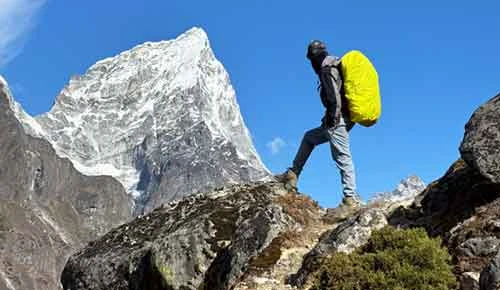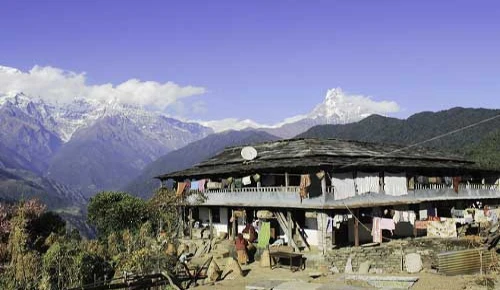Medical Rescue and Evacuation Service Nepal
When people travel to different places, they want to make sure they get there safely and without any problems. That's where rescue and evacuation come in. With the help of helicopters, it helps people in Nepal who need medical help or are stuck in difficult places like mountains.
Regular ambulances can't reach some of these places, but helicopter rescue and evacuation can. It goes to remote villages, mountain areas, and trekking routes to bring medical help to those who need it.
This also helps find and rescue people who are lost or in trouble while hiking and delivers important medical supplies to places that are hard to reach.
In emergencies, time is really important. Helicopters can quickly get patients to hospitals, where they can get the care they need. The goal is to make healthcare better in Nepal, keep tourists safe, and save lives.
Table of Contents
Why is the rescue and evacuation service important?
Nepal is a country known for its Himalayas. One of the main reasons tourists are drawn to Nepal is because of its trekking routes to the Himalayas.
Trekking to the Himalayas can be fun as well as challenging. To ensure the safety of the traveler, rescue and evacuation services play a vital role. Here are some of the reasons why rescue and evacuation services are crucial.
- Safety: Risks associated with trekking and mountaineering include altitude sickness, accidents, avalanches, and severe weather. In an emergency, climbers and trekkers are guaranteed safety by prompt rescue and evacuation services.
- Remote Locations: A lot of Nepal's trekking and climbing routes are situated in untamed, isolated places that are frequently far from towns and medical services. In these places, where getting medical assistance might be difficult, having quick access to rescue services is essential.
- Difficulties at Altitude: Nepal is home to some of the highest peaks in the world, including Mount Everest. Significant health hazards associated with high altitude include acute mountain sickness, cerebral edema, and pulmonary edema. Trekkers and climbers need rescue services that are prepared to handle situations connected to altitude.
- Unpredictable Weather: In mountainous areas, the weather can abruptly shift and become quite hot. Trekkers and climbers can get stuck or in danger due to sudden storms, blizzards, and avalanches. To remove those who remain in such circumstances, rescue services are essential.
Helicopters for Rescue and Evacuation
Helicopters play a crucial role in rescue and evacuation. Below are some of the reasons why helicopters are required for rescue and evacuations.
- Rapid Response: Rescue teams can reach damaged regions swiftly, even in difficult weather or rough terrain, thanks to helicopters' rapid response capabilities. When quick medical assistance or evacuation is required to save lives, this speed can be extremely important.
- Access to remote areas: Helicopters can provide access to areas that are difficult or impossible to reach, such as hilly regions, densely forested areas, and areas devastated by earthquakes or floods. Their capacity to hover and descend in small areas makes them vital for assisting stranded people or remote populations.
- Medical Evacuation: Quick and safe transportation of seriously injured or sick people to medical institutions is possible using helicopters. They frequently have medical staff and equipment on board, enabling in-flight medical treatment and patient stabilization while the patient is being transported to a hospital or trauma center.
- Search and Rescue: Helicopters are very useful in search and rescue missions because they are outfitted with specialist gear, including thermal imaging cameras, night vision goggles, and rescue hoists. They are able to swiftly explore wide regions, find missing people, and rescue them from dangerous situations.
Significant Destinations for Helicopter Rescue and Evacuation in Nepal
The Everest region of Nepal is one of the most popular locations for helicopter rescue and evacuation. The tallest mountain in the world, Mount Everest, draws trekkers and climbers from all over the world.
However, because of the extremely high altitude and unforgiving environment, there have been several occurrences necessitating emergency evacuation. Places like Everest Base Camp and the neighboring high-altitude camps are vital hubs for helicopter rescues that help get injured climbers and trekkers out of danger's way.
Important locations for helicopter rescue missions also include the Annapurna Circuit and Annapurna Base Camp. Trekking paths in the Annapurna region are known for their difficult nature and stunning landscape.
However, trekkers experience a higher risk of accidents and medical issues because of the challenging terrain and erratic weather patterns. When someone has injuries, altitude sickness, or other health issues, helicopters are frequently called in to save them; the main evacuation station is Annapurna Base Camp.

Similarly, the Langtang region is also a significant destination for helicopter rescue and evacuation in Nepal. The region is a well-liked hiking destination that draws adventurers and nature lovers because of its unspoiled landscapes and rich cultural legacy. That being said, the area is vulnerable to landslides and avalanches, especially in light of the terrible 2015 earthquake.
In the Langtang Valley, helicopter rescue missions are essential for the evacuation of wounded hikers, the provision of medical care, and the assistance of nearby villages in times of need. In the Langtang area, Langtang Village, Kyanjin Gompa, and other isolated communities along hiking routes are important locations for helicopter evacuations.
There are other significant destinations, like the Manaslu region, Mustang region, Kanchenjunga region and more, where these rescue and evacuation services play a significant role in saving trekkers or climbers lives. Remote villages and communities dispersed throughout Nepal's hilly areas, in addition to well-traveled hiking routes, are essential locations for helicopter rescue and evacuation.
These villages have a difficult time getting medical assistance in an emergency since they are frequently located at high altitudes and are unreachable by road. Helicopters are essential for quickly and effectively reaching these remote locations and transferring injured people to hospitals or other medical facilities for treatment.
The Role of Helicopter Evacuation in High-Altitude Trekking
Since they are traveling and ascending at a higher altitude, trekkers and climbers may become ill in Nepal's high, raised Himalayan area. They require an evacuation in such a situation. If not, this illness may kill them.
Since there is no access to a road ambulance or a well-maintained hospital, the only choice is to charter a helicopter. Thus, to save the lives of trekkers and climbers, Nepal Trek Adventure provides the quickest medical evacuation and rescue service.
Patients suffering from altitude sickness must descend to a lower altitude as quickly as possible. Therefore, the best way to transfer patients to the lower altitude area and to the hospital for additional care is by helicopter.

Our rescue crew has received expert training. Our pilot has a great deal of expertise flying the helicopter in a remote area of Nepal. When it comes to rescuing and saving lives, our service is incredibly trustworthy and effective.
One option for critically ill travelers who are in a remote area of Nepal where neither the hospital nor road access are available is a helicopter evacuation. It is the quickest and most effective method of moving people from one location to another.
It is often known that Nepal is a hilly and mountainous nation. There are still many areas without roads and hospitals.
Additionally, the locations where access to the roads is possible are likewise in poor shape, making it take a while to go to the cities. Therefore, this is required to rescue those who require immediate medical attention.
For travelers who require immediate medical attention and are very ill, Nepal Trek Adventure provides emergency medical evacuation services. We also assist in making contact with the nearby hospital so that, in an emergency like this, travelers can receive immediate care.
Helicopter Rescue Operations during Natural Disasters
Since traditional ground-based rescue operations are difficult in Nepal due to the country's rural towns and rough terrain, helicopter rescue operations are essential during natural disasters.
Helicopters play a crucial role in quickly reaching and evacuating impacted communities, delivering necessary supplies, and giving medical aid during catastrophes like earthquakes, floods, or landslides.
Helicopters are used in several ways during natural disasters, such as airborne surveillance to determine damage levels, pinpoint regions in need, and organize rescue operations. Helicopters equipped with cutting-edge imaging equipment may give disaster response teams crucial real-time information, allowing them to efficiently use resources and prioritize rescue operations.
Helicopters are also essential for evacuating wounded or trapped people to hospitals, particularly in regions with badly damaged infrastructure or blocked roads.
Challenges Faced During Helicopter Rescue and Evacuation
Even though helicopter rescue and evacuation have come a long way in Nepal, there are still various challenges that are faced during helicopter rescue and evacuation. Here are some of the major challenges.
- Weather: Helicopter operations can get delayed or canceled due to unpredictable and harsh weather, particularly in mountainous areas like Nepal.
- High Altitude Operations: There are several difficulties associated with flying at high altitudes, including decreased engine performance, thinner air, and a higher chance of hypoxia for both crew and passengers.
- Restricted Landing Zones: Undeveloped and isolated areas frequently have insufficient landing zones, forcing experienced pilots to make precise landings in confined places or on unstable terrain.
- Navigational Challenges: Pilots can find it challenging to maintain situational awareness and navigate safely due to complex terrain and inadequate navigational aids, particularly in adverse conditions.
- Medical Considerations: It can be difficult to provide prompt and adequate medical treatment during evacuations, particularly in high-altitude locations where hypothermia, altitude sickness, and other medical problems are frequent occurrences.
Insurance for Rescue and Evacuation Services in Nepal
It is strongly advised that travelers to Nepal, especially those who want to hike or mountaineer in isolated, high-altitude areas, purchase insurance that covers helicopter rescue and evacuation services.
Owing to the unpredictability of outdoor activities and the possible hazards of altitude sickness, mishaps, or natural catastrophes, having sufficient insurance can offer comfort and monetary security in an emergency.
Several insurance plans are designed especially to pay for helicopter rescue and evacuation services in Nepal.
These insurance policies usually cover expenditures associated with medical evacuation, such as hospitalization fees, emergency medical care, and helicopter airlifts from distant locations to medical facilities.
Travelers should take into account the following aspects while acquiring insurance for helicopter rescue and evacuation services in Nepal:
- Make sure you have full coverage for altitude sickness, accidents, injuries, and medical emergencies when it comes to helicopter rescue and evacuation services.
- Examine the coverage limitations to make sure that rescue and evacuation costs are sufficiently covered.
- Make sure your policy covers pre-existing medical issues, as some may not cover them or require waiting periods.
- Verify coverage for adventurous pursuits like hiking and climbing, making sure it corresponds with the schedule of events.
- Look for insurance policies that include helicopter operators, local agencies, and 24/7 emergency help services.
- Take specific note of the policy's exclusions, limits, and conditions with relation to alcohol and/or drugs, prohibited locations, and carelessness.
Plan a Safe Himalayan Adventure
Lastly, Nepal's rescue and evacuation services are essential to guaranteeing travelers' security and welfare while they traverse the nation's varied and difficult landscapes.
From the high alpine peaks of the Himalayas to isolated mountain settlements, our helicopter rescue teams are prepared to react quickly to crises, offering medical support and evacuations as necessary.
Getting comprehensive insurance coverage that includes helicopter rescue and evacuation services should be a top priority for visitors to Nepal who are going to engage in outdoor activities like hiking or climbing.
Furthermore, adequate planning, which includes acclimatization, following safety regulations, and keeping track of the weather, can help reduce dangers and improve general safety when engaging in outdoor activities in Nepal.
In Nepal, visitors can take in the breathtaking grandeur of its surroundings while feeling secure in the knowledge that their safety is guaranteed while traveling with us.








